Sustrans Shared Use Paths
4th September 2021
Cycling in Yorkshire

4th September 2021
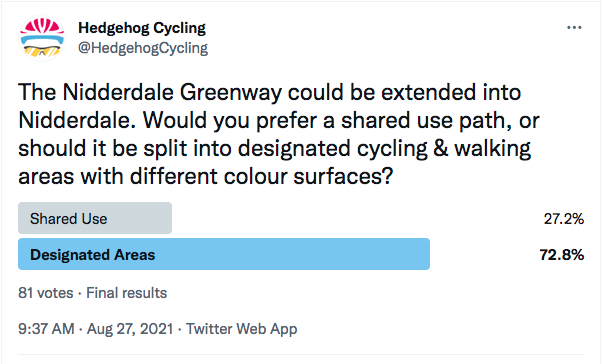
The people have spoken: no more shared use paths on the Sustrans National Cycle Network, thank you.
Ok, it's only 81 people on Twitter - but once the Conservative Party has inflicted its cynical voter suppression measures on the country, eighty-one could be the whole electorate of the UK.
Let me clear one thing up first: when I'm riding a bike on a shared use path I am patient and polite, and I always slow right down or stop when it's necessary. I understand the nature of the path, and cycle accordingly.
This post isn't about how to ride on existing shared use paths; it asks how to build new cycle infrastructure to the best possible standards.
People on bikes and people walking don't mix all that well; the obvious difference is the speed at which they travel.
The difference in speed is recognised in Chapter 8 of Cycle Infrastructure Design LTN 1/20, about traffic-free routes.
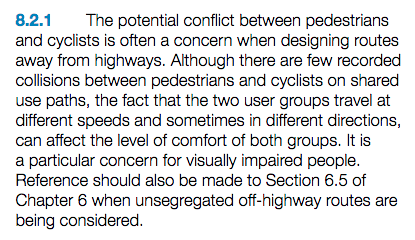
Maintaining momentum is a very important aspect of cycling, and it is part of the Core Design Principle in LTN 1/20 that routes should be Direct.
'Minimising the effort required to cycle, by enabling cyclists to maintain momentum, is an important aspect of directness.'
Para 4.2.7, LTN 1/20
Especially when it's busy on shared use paths you have to slow down or stop quite often, losing your momentum. Of course you should slow down without complaining - but that doesn't make it good cycle infrastructure.
The principle that good cycle routes allow riders to maintain momentum is reiterated in Table 4-1.

Because shared use paths lump together people walking and those on bikes, they aren't the best possible infrastructure; and from a cycling point of view, constantly losing momentum is one of the inconveniences.
Providing separate areas for walking and cycling is almost always preferable. Does anyone look at this bridge in the Netherlands and think 'if only it could be shared use' like the Camarthen version?
'Where space and budget allows, the most effective way to minimise conflict and increase comfort is to provide separate routes for walking and cycling. This technique is commonly used on Forestry Commission land...'
Para 8.2.3, LTN 1/20
If that can't be done, the guidance suggests a level difference and/or different surface texture.

If the surface is level, there should be a raised trapezoidal strip to separate the walking and cycling areas (para 8.2.5).
It is sometimes said that shared use forces people to learn to be considerate. I would say that isn't the purpose of cycle infrastructure.
I believe designers should build the best cycle path they can, not deliberately inflict something inconvenient on people as a means to improve their moral character.
You could insist people wear hair shirts while riding if you really want to create a test of moral fortitude, but few would consider that a good idea.
It is argued that a path with segregated areas would have to be wider, and so would have greater environmental impact.
I believe that walking and cycling infrastructure has a net environmental benefit, and an extra metre and a bit of width is well worth it if it increases use, especially for commuting or other utility cycling.
The government has committed £27 billion to new main roads, and the full width of a motorway is over 22m. HS2 is costing over £100 billion, and the width is 19m. These are genuinely damaging projects with a huge environmental impact: turn your fire on them.
We know we need to increase walking and cycling for environmental reasons, and it's counter-productive to object to the infrastructure that enables it on environmental grounds.
It is said that Sustrans paths are only for slow and leisurely cycling - but this is the National Cycle Network we're talking about! Surely it should be suitable for cycling at a normal speed.
"If you want to go faster than 12mph, this path is not for you." But what are the alternatives - are there lots of other cycle paths where I can ride? No.
"You have to ride on the road." That's all very well if there are suitable quiet roads, but if you're suggesting I take the B6165 to Pateley Bridge, that's not an acceptable option. Even people who want to ride at a normal speed don't like being run over by SUVs on terribly busy B-roads.
Inclusive cycling means that paths should cater for less confident cyclists as a first priority. The second priority should be to make the cycle paths suitable for as many cyclists as possible, rather than excluding people.
Another argument you sometimes hear for shared use is "I like to stop and chat." That's great, but you'll still be able to stop and chat on a path with designated areas.
And realistically, we all like to stop and chat sometimes, but at other times we have places to go and don't want to stop and chat; that doesn't make us morally inferior.
I've it heard it said that Sustrans get more complaints where paths are segregated, because people are more territorial.
I can believe that, but I don't think the number of phone calls to the Sustrans office should be the determining factor in designing cycle routes. The objective should be to build the best cycle paths possible.
It seems to me that Sustrans have been giving the same justifications for shared use for so long that they've stopped thinking about whether they are really valid.
The poll shows pretty clearly what most people would prefer. Maybe it's time to start listening to people again, instead of explaining to them what's good for them?
There is an exciting project to extend the Nidderdale Greenway to Pateley Bridge and beyond. The Feasibility Study envisages a 2m-wide path.
That almost certainly means shared use, according to para 8.2.8, LTN 1/20.
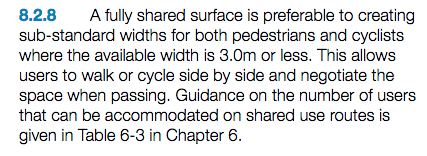
I'd say that now is the time to speak up and ask for a better design standard, before all the decisions are made. Let's build the Nidderdale Greenway Extension to excellent standards. If not here and now, where and when? Why is it that other countries are allowed to have really good cycle infrastructure but we in Britain are not?
If it ends up being shared use that will be disappointing but c'est la vie, as we used to say in the pre-Farage time.
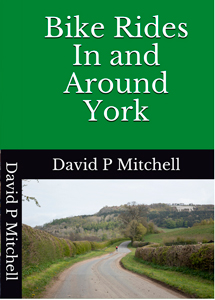
Bike Rides In and Around York starts a city tour of York, then there are wonderful family, road, and mountain bike rides.
It's intended to inspire you discover York and the surrounding countryside on two wheels.
Each ride comes with a map and GPS files that you can upload to a device.
'This book is simply a treasure trove not only of great rides but also as a travel guide to the area.' Reader review, July 2021.
Find out more about Bike Rides In and Around York, and buy a copy.
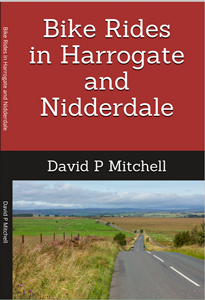
Bike Rides in Harrogate and Nidderdale is a book of family, mountain and road bike rides.
"This guide is a wonderful companion whether you ride alone, with family or friends. Don't set out without it."
Read more about Bike Rides in Harrogate and Nidderdale.